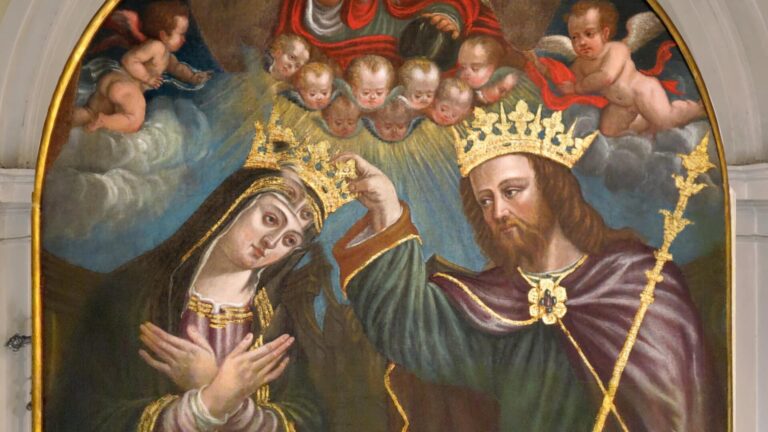ARTISTS’ ROADS
LE VIE DEGLI ARTISTI
watch the videos at the bottom of the page!
CODOGNE’ – ROVERBASSO
The Return to Roverbasso of an Ancient Altarpiece
Towards the end of the sixteenth century, an unknown painter created an altarpiece of the Coronation of the Virgin.
His source of inspiration was undoubtedly a fifteenth-century fresco, still visible in the chapel of the noble Galletti family, in the Church of San Giovanni dei Carmelitani in Serravalle. We can picture him, head tilted upward, sketching its key features, as a reference for his own composition.
But there was another painting close to his heart. The exquisite panel created earlier that century by Andrea Previtali of Bergamo in Santa Maria del Meschio. That serene face, that gentle posture of Mary, the sense of humility and acceptance it conveys, lent itself perfectly to the crowned Virgin he wished to portray.
And so we arrive at the finished work. A focus on the solemn gesture of the Son toward the Mother, from this moment forth, Queen of Heaven and Earth.
The two figures, placed in the foreground, seem to emerge from the painting. Mirrored in pose, they sit on wooden thrones with curved backs. These rest on a step paved with marble tiles.
The artist dresses them in rich garments trimmed with gold. It is a solemn ceremony, one that demands elegance and refinement. The sceptre in His hand is gold, as is the clasp of His cloak, a six-petalled flower set with gemstones. The crowns too are gold, encrusted with pearls. The shoes peeking from beneath the robes are liturgical red, a blazing hue.
The Virgin, her head gently bowed, responds to the gesture of the Son. Even in Heaven, the unique bond between them endures. Her hands are crossed upon her chest. As if in a new Annunciation.
Above them, God the Father holds the orb in His left hand, and blesses the event, surrounded by the heavenly court.
Recently, the painting returned to the parish church of Roverbasso. For many years, it had been housed in the Albino Luciani Museum of Sacred Art in Vittorio Veneto. It had been moved there due to its fragile state of preservation. There, it was proudly displayed after an important restoration, carried out by the Central Institute for Conservation in Rome.
It now once again occupies a central position. Set within a stucco frame on the rear wall of the presbytery. Although this is not its original setting. The work was certainly created as an altarpiece, later altered in shape and size to suit a different arrangement.
It is touching to imagine that Blessed Father Cosma Spessotto, born in Mansuè, but raised in Roverbasso, once lifted his gaze toward this Coronation of the Virgin.
This parish church, with its airy green space along the Resteggia River, was for him a place of the heart.
A Franciscan missionary in El Salvador from 1950 onward, he always returned gladly to his people here. To family. To friends. During his four visits back to Italy, between 1958 and 1978, he found here a time of rest, in an atmosphere of serenity, welcome, and affection.
In this church, he loved to pray and to celebrate Mass.
So much so, that when the time came to build a church for his community in San Juan Nonualco, where he served as parish priest, he took this one as his inspiration. Complete with its distinctive entrance through the bell tower. It was a tribute, across the ocean, to his beloved home.
MORE EXPERIENCES!
L’immagine di Maria nelle pale d’altare:
- Cima da Conegliano nel duomo di Conegliano
- Francesco da Milano nella parrocchiale di Lago
- Francesco Beccaruzzi nell’arcipretale di Mareno di Piave
- Andrea Previtali nella parrocchiale di Meschio, Vittorio Veneto
MULTIMEDIAL MAP: “ARTISTS’ ROADS – LE VIE DEGLI ARTISTI- EN”!

